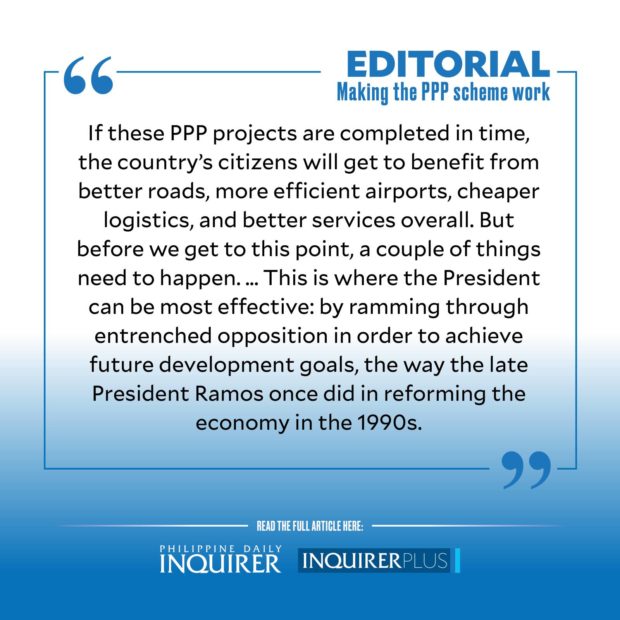Making the PPP scheme work
The bad news is that the government has limited resources with which to build all the so-called big ticket projects that the Philippines needs to achieve its goals of growing the economy faster and improving the standards of living of 110 million Filipinos.
The good news is that the Marcos Jr. administration has decided to shift back to partnering with the business sector, which has all the funds needed to execute all these badly needed projects, especially in the field of infrastructure.
The bad news is that the public-private partnership (PPP) scheme, which President Marcos Jr. will be relying on to achieve the government’s development goals, has gotten the bad rap, no thanks to its less-than-ideal execution in previous years.
The good news is that this administration has hopefully—fingers crossed, and knock on wood—learned how to avoid the pitfalls of the PPP system and will, henceforth, be able to get more projects off the ground faster, with greater participation across a wider spectrum of private investors and, most importantly, get them completed sooner.
Over the weekend, the Marcos Jr. administration announced that the National Economic and Development Authority is currently vetting 206 large projects worth an estimated $159 billion, and that a final list would be ready by the end of this quarter.
This is an encouraging development for all stakeholders concerned, especially for the government which has to find ways of nurturing the country’s fragile recovery from its worst economic slump since World War II, no thanks to the ravages of the coronavirus pandemic.
Also, no thanks to the COVID-19 crisis, the government’s ability to take on more debt to fund economic growth—the preferred route of the previous administration—is no longer a viable option. The Philippines’ overall debt level now stands at slightly over 60 percent of total economic output, which is the threshold considered “prudent” by the international community.
This left Mr. Marcos no other option but to enlist the financial muscle of private investors, local primarily, but also foreign, hopefully, to help execute plans to build more roads and highways, bridges, air and seaports, as well as health and education facilities, among others.
This policy decision is great news for the private sector, which remains awash with cash (thanks to the lingering effects of low interest rates of the previous years). Deployed properly, these resources can help fund productive sectors, which would yield decent returns for businessmen and benefit Filipinos in general.
At the same time, if these PPP projects are completed in time, the country’s citizens will get to benefit from better roads, more efficient airports, cheaper logistics, and better services overall.
But before we get to this point, a couple of things need to happen.
First, the Marcos Jr. administration must show its resolve in implementing challenging PPP projects, especially when a deal calls for sacrifices on one or more stakeholders involved (such as securing right-of-way access from intransigent landowners or convincing people to pay a little more for more efficient delivery of utility services, for example).
Breaking through inevitable roadblocks like these will be the proper use of Mr. Marcos’ large reserve of political capital, which he has yet to deploy a few months into the job.
The other thing that needs to happen is for the private sector to stop fighting over juicy projects, as they have in recent years. These long-drawn-out battles often end up delaying project implementation and higher costs for everyone involved, be it the government, the private proponents, or the end users.
And with over 200 big ticket projects in play, there are enough investment opportunities to go around for all private investors, whether they be large conglomerates with billions in cash or smaller entrepreneurs with specific expertise needed for their successful implementation. There is something for everyone who wants to make a decent return on investment and help build the nation at the same time.
The bad news is that the PPP system is imperfect, and some parties who are currently enjoying the status quo or profiting from inefficiencies will inevitably be upset by reforms.
The good news is that the PPP system can work once stakeholders—the government, the private sector, and the public—look beyond their short-term interests and focus on longer-term objectives.
This is where the President can be most effective: by ramming through entrenched opposition in order to achieve future development goals, the way the late President Ramos once did in reforming the economy in the 1990s.
The sooner he does this, the better.





















